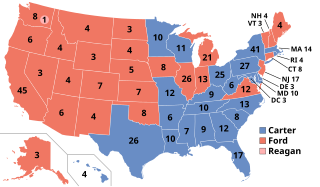
The 1976 United States presidential election was the 48th quadrennial presidential election, held on Tuesday, November 2, 1976. Democrat Jimmy Carter, former Governor of Georgia, defeated incumbent Republican president Gerald Ford in a narrow victory. This was the first presidential election since 1932 in which the incumbent was defeated, as well as the only Democratic victory of the six presidential elections between 1968 and 1988.
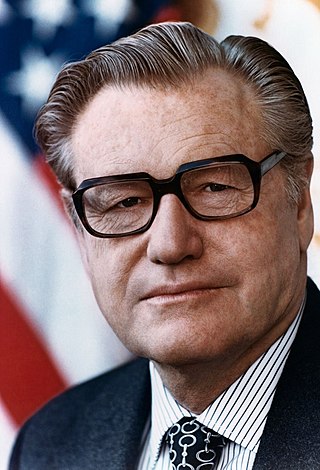
The Rockefeller Republicans were members of the United States Republican Party (GOP) in the 1930s–1970s who held moderate-to-liberal views on domestic issues, similar to those of Nelson Rockefeller, Governor of New York (1959–1973) and Vice President of the U.S. (1974–1977). Rockefeller Republicans were most common in the Northeast and the industrial Midwestern states, while they were rare in the South and the West.

Gerald Ford's tenure as the 38th president of the United States began on August 9, 1974, upon the resignation of President Nixon, and ended on January 20, 1977, a period of 895 days. Ford, a Republican from Michigan, had served as vice president since December 6, 1973, following Spiro Agnew's resignation from that office. Ford was the only person to serve as president without being elected to either the presidency or the vice presidency. His presidency ended following his defeat in the 1976 presidential election by Democrat Jimmy Carter.
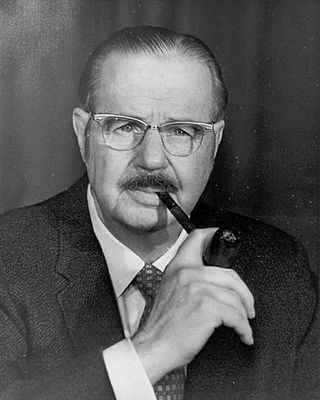
Hugh Doggett Scott Jr. was an American politician. A member of the Republican Party, he represented Pennsylvania in the U.S. House of Representatives from 1941 to 1945 and from 1947 to 1959 and in the U.S. Senate, from 1959 to 1977. He served as Senate Minority Leader from 1969 to 1977.

James Lane Buckley was an American politician and judge who served in the United States Senate as a member of the Conservative Party of New York State in the Republican caucus from 1971 to 1977 and additionally held multiple positions within the Reagan administration. He was also the Republican nominee in the 1980 Connecticut Senate race, but he was defeated by Democrat Chris Dodd.

Dan Heflin Kuykendall was an American politician and businessman who served as a United States Representative from Tennessee's 8th and 9th congressional districts from 1967 until 1975. A member of the Republican Party, Kuykendall was the first Republican to be elected in the 8th district since 1920 and was the first to be elected in the 9th district since 1872.

Charles Ellsworth Goodell Jr. was an American politician who represented New York in the United States House of Representatives from 1959 to 1968 and the United States Senate from 1968 to 1971. In both cases he came into office following the deaths of his predecessors, first in a special election and second as a temporary appointee succeeding Robert F. Kennedy.

Carl Thomas Curtis was an American attorney and politician from the U.S. state of Nebraska. He served as a Republican in the United States House of Representatives (1939–1954) and later the United States Senate (1955–1979). He remains the second longest-serving Senator from Nebraska.

The Watergate scandal refers to the burglary and illegal wiretapping of the headquarters of the Democratic National Committee, in the Watergate complex by members of President Richard Nixon's re-election campaign, and the subsequent cover-up of the break-in resulting in Nixon's resignation on August 9, 1974, as well as other abuses of power by the Nixon White House that were discovered during the course of the scandal.

Peter A. Peyser was a United States representative from New York, serving from 1971 to 1977 as a Republican and from 1979 to 1983 as a Democrat.

Charles William Sandman Jr. was an American Republican Party politician who represented Cape May County in the New Jersey Senate from 1954 to 1966 and represented southern New Jersey in the United States House of Representatives from 1965 to 1975. He ran for the Republican nomination for Governor of New Jersey three times, losing to Wayne Dumont in 1965 and William T. Cahill in 1969, but finally receiving the nomination by defeating incumbent Governor Cahill in 1973. He lost the 1973 general election to Brendan Byrne in a historical landslide.

From August 16 to August 19, 1976, voters of the Republican Party chose its nominee for president in the 1976 United States presidential election. The major candidates were incumbent President Gerald Ford and former Governor of California Ronald Reagan. After a series of primary elections and caucuses, neither secured a majority of the delegates before the convention.
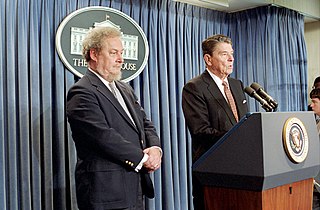
On July 1, 1987, President Ronald Reagan nominated Judge Robert Bork for Associate Justice of the Supreme Court of the United States, to succeed Lewis F. Powell Jr., who had earlier announced his retirement. At the time of his nomination, Bork was a judge on the United States Court of Appeals for the District of Columbia Circuit, a position to which he had been appointed by President Reagan in 1982.

Electoral history of Nelson Rockefeller, who served as the 41st vice president of the United States (1974–1977), the 49th governor of New York (1959–1973), and was a three-time candidate for the Republican Party presidential nomination.

Nelson Aldrich Rockefeller, sometimes referred to by his nickname Rocky, was an American businessman and politician who served as the 41st vice president of the United States from 1974 to 1977 under President Gerald Ford. A member of the Republican Party and the wealthy Rockefeller family, he previously served as the 49th governor of New York from 1959 to 1973. Rockefeller also served as assistant secretary of State for American Republic Affairs for Presidents Franklin D. Roosevelt and Harry S. Truman (1944–1945) as well as under secretary of Health, Education and Welfare (HEW) under Dwight D. Eisenhower from 1953 to 1954. A son of John D. Rockefeller Jr. and Abby Aldrich Rockefeller as well as a grandson of Standard Oil co-founder John D. Rockefeller, he was a noted art collector and served as administrator of Rockefeller Center in Manhattan, New York City.

The 1976 United States elections were held on November 2, and elected the members of the 95th United States Congress. The Democratic Party won the presidential election and retained control of Congress.
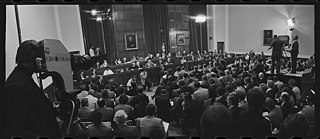
The impeachment process against Richard Nixon was initiated by the United States House of Representatives on October 30, 1973, during the course of the Watergate scandal, when multiple resolutions calling for the impeachment of President Richard Nixon were introduced immediately following the series of high-level resignations and firings widely called the "Saturday Night Massacre". The House Committee on the Judiciary soon began an official investigation of the president's role in Watergate, and, in May 1974, commenced formal hearings on whether sufficient grounds existed to impeach Nixon of high crimes and misdemeanors under Article II, Section 4, of the United States Constitution. This investigation was undertaken one year after the United States Senate established the Select Committee on Presidential Campaign Activities to investigate the break-in at the Democratic National Committee headquarters at the Watergate office complex during the 1972 presidential election, and the Republican Nixon administration's attempted cover-up of its involvement; during those hearings the scope of the scandal became apparent and the existence of the Nixon White House tapes was revealed.

This article lists those who were potential candidates for the Republican nomination for Vice President of the United States in the 1976 election. At the 1976 Republican National Convention, incumbent President Gerald Ford narrowly won the presidential nomination over former California Governor Ronald Reagan. Ford had decided not to choose Vice President Nelson Rockefeller as his running mate, due to Rockefeller's unpopularity with the right wing of the Republican Party. He instead chose Senator Bob Dole of Kansas. Dole was acceptable to the conservative wing of the party, and Ford hoped that Dole would help the ticket win the western states and the agricultural vote. The Ford–Dole ticket lost the general election to the Carter–Mondale ticket. Though he would not win the presidential nomination, Reagan announced before the convention that he would pick Senator Richard Schweiker of Pennsylvania as his running mate. Dole went on to become Senate Republican leader, and the Republican presidential nominee in 1996, losing the general election to incumbent President Bill Clinton.

On October 10, 1973, Vice President Spiro Agnew was forced to resign following a controversy over his personal taxes. Under the terms of the 25th Amendment, a vice presidential vacancy is filled when the president nominates a candidate who is confirmed by both houses of Congress. President Richard Nixon thus had the task of selecting a vice president who could receive the majority support of both houses of Congress, which were then controlled by the Democrats.

On September 26, 2020, President Donald Trump announced the nomination of Amy Coney Barrett to the position of Associate Justice of the Supreme Court of the United States to fill in the vacancy left by the death of Ruth Bader Ginsburg. At the time of her nomination, Barrett was a Judge of the United States Court of Appeals for the Seventh Circuit in Chicago, Illinois. The Senate received word from the president on September 29.

















